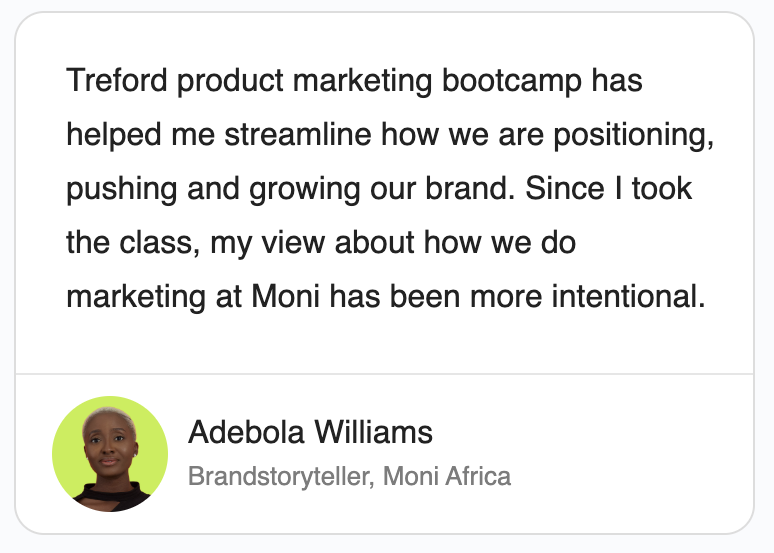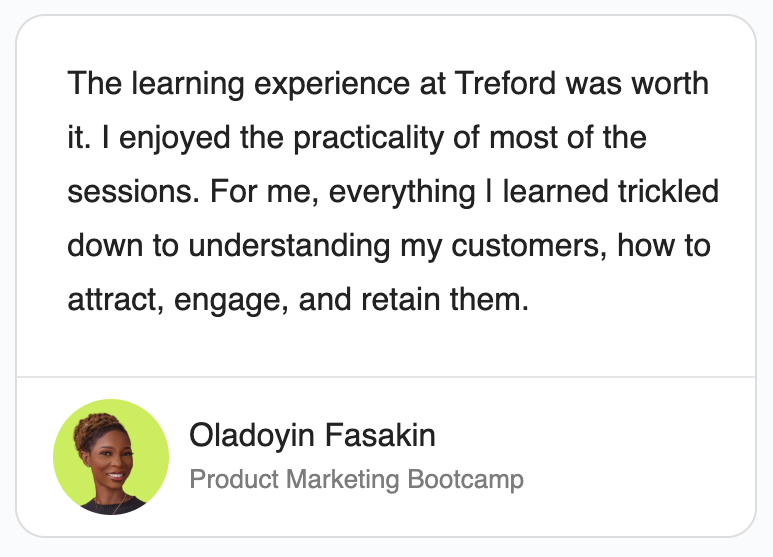Stepping into the product marketing manager role is both exciting and nerve-wracking. You must quickly master your role to lead your team, align with stakeholders, and deliver results.
But let’s be real: walking into an existing team has its challenges.
- How do you introduce yourself without being overbearing?
- How do you balance proving your value while earning trust?
- How do you align with leadership while ensuring your team feels heard?
We know the feeling, so we brought in someone who’s been there. Our content manager, Esther Osatuyi, sat down with Bolaji Anifowose, Product Marketing Manager (Partnerships & Integrations) at Distrobird, to unpack how he’s handled these exact moments in his career.
From handling your first team meeting to aligning with company goals, we break down key moves that’ll help you build credibility, gain momentum and make your mark — all in your first 90 days.
First Impression Matters: Listen Before You Lead
As soon as you become a product marketing manager, the heat is on. Your team expects clarity, leadership is tracking results, and imposter syndrome might tag along. It’s a lot, especially when you’re trying to prove yourself fast without burning out.
So, how do you make a strong first impression without rushing into decisions? Bolaji shares how he navigated that pressure and why choosing to listen first makes all the difference:
Regardless of your years of experience, joining a new company means navigating existing dynamics. I learned early on that my best move was to listen first. — Bolaji
Instead of making immediate changes, observe the culture, workflows, and existing relationships. This will help you identify patterns and avoid missteps early on.
Pro Tip: Resist the urge to prove yourself too quickly. Spend your first few weeks absorbing insights and getting to know the team and the company’s nuances.
Read the Room: Understand the Unspoken Dynamics
Office politics is real—even if it’s subtle. In any team, especially in physical workspaces, people are always observing, forming alliances and protecting their turf.
Change naturally brings discomfort. And when new leadership steps in, it can trigger uncertainty and quiet resistance. People may not say it out loud, but they’re watching—trying to figure out if you’re here to collaborate or steamroll your way through.
That’s why your first job isn’t to prove you’re in charge. It’s to build trust. Show your team you value their work and you’re not here to tear down what they’ve built. That’s how you lower walls and start leading effectively.
Here is Bolaji’s approach to moments like this:
Before jumping into execution, I scheduled one-on-ones with key stakeholders. These conversations helped me understand expectations and pinpoint quick wins. Another approach is to ask your team questions; it will help you understand how they view your role and lead them more effectively toward hitting growth and revenue goals. — Bolaji
How to do the same:
- Schedule one-on-one meetings with stakeholders to understand their goals.
- Ask open-ended questions that delve into their goals, challenges and what success means to them.
- Take notes on recurring themes; these will help inform your priorities.
- Observe before proposing changes to get a sense of how things are done—the rhythm, the quirks and the unspoken rules.
Pro Tip: It’s less about making a splash and more about showing you’re there to understand, support and lead with intention.
Balancing Quick Wins with Strategic Vision
One of the biggest mistakes a first-time marketing manager could make is trying to fix everything at once.
The key is balancing immediate impact with long-term strategy.
The Low-Hanging Fruit Principle suggests starting with simpler, high-impact tasks that can be completed quickly and efficiently. Small wins trigger the release of dopamine, which fuels motivation and momentum. This aligns with the Progress Principle (Amabile & Kramer, 2011), as reported in the Harvard Business Review, which shows that even minor achievements can significantly boost confidence and productivity.
Bolaji shares a smart approach that worked for him:
I asked my manager, ‘What would you consider quick wins for my role?’ In one position, I learned that securing a partnership with a Canadian company was a top priority. That insight helped me focus my early efforts. — Bolaji
Quick Wins could be refining an underperforming campaign, improving reporting systems, or optimising an existing process, while Long-Term Goals could mean restructuring workflows, launching new initiatives, or improving team collaboration.
Pro Tip: Align with your management on both to ensure you’re delivering value in ways that matter.
Leading Through Influence, Not Authority
When stepping into a new leadership role, expect some resistance—it’s a regular part of the process. Change is uncomfortable and people naturally cling to what they know. But great leadership isn’t about bulldozing your way through. It’s about building trust, showing empathy, and guiding your team forward.
This is how Bolaji simply suggests you approach your new team:
Listening first, makes people more open to your ideas. If you start making changes immediately, they’ll resist. Instead, acknowledge what’s working before suggesting improvements. — Bolaji
Our cofounder and CEO, Harry Enaholo, shares a similar view below:
When you look at companies that grew from small teams into successful, sustainable businesses, it’s never just about having a visionary founder. What really moves the needle is when people across the team take ownership because they’ve been empowered to. “That’s why I don’t believe in leading with fear. The only real choice is to empower your team. That’s what guides my leadership.— Harry
How do you lead with influence, not fear?
- Acknowledge existing processes before recommending changes.
- Celebrate what’s working—your team needs to feel seen.
- Be transparent about your goals and bring others into the vision.
- Identify internal champions who can help drive new ideas.
- Instead of enforcing change, co-create it with your team.
Want to better navigate these kinds of leadership dynamics with teams and stakeholders?
Pro Tip: Check out this course on our site to manage stakeholder relationships with clarity and confidence.
Managing Up & Out: Aligning with Leadership and Other Teams
As a marketing lead, your job doesn’t stop at your team. You’re also managing expectations from leadership and building solid relationships across other departments.
Bolaji mentioned he learned this the hard way:
One of my biggest lessons was checking in with other teams regularly. If you don’t, priorities get misinterpreted and execution slows down. — Bolaji
And when you’re pushing for new hires or better tools? You’ve got to come with receipts. Leadership won’t just take your word for it—they want the numbers, the why, and the impact.
That’s precisely one of the major themes Seun Olayiwola, Group Head of MarTech & Analytics at WakaNow (and a facilitator at Treford), covers in this masterclass—how to present your case with data that sticks.
How to manage up effectively:
- Provide clear progress updates; concise, data-driven reports work best.
- Tie your team’s efforts to business goals to reinforce alignment.
- Address concerns proactively; don’t wait for issues to escalate.
Pro Tip: Above all, be transparent, upward and downward. That’s how you build trust, avoid surprises, and keep things moving forward.
Setting the Stage for Long-Term Success
Your first 90 days should set a foundation for sustained impact, so it’s important to be intentional about your approach from day one and learn from people who have walked the same path.
Bolaji shares a structured approach that works for him:
I conducted a skills audit in my first month to assess the strengths and weaknesses of the team. This helped me identify gaps and optimize processes. — Bolaji
Steps to establish long-term success:
- Assess your team’s strengths & weaknesses; identify skill gaps early.
- Optimize workflow and streamline inefficient processes.
- Clarify team responsibilities and set clear expectations.
Hattie, a PMM who shares her journey on YouTube, made a solid point—enjoy your first 30 days. Yes, even if you’re still on probation. It helps you ease into the role without getting overwhelmed by everything that feels urgent.
That mindset sets the tone: take your time, assess the landscape and move with purpose. It’s how you uncover growth opportunities, strengthen your team, and actually make an impact—without burning out.
Stepping into a marketing leadership role is a big moment. It comes with pressure, sure—but also real opportunity. If you lead with curiosity, build strong relationships, and balance the quick wins with long-term thinking, you’re already on the right track.
You don’t need all the answers on day one. Just bring your willingness to learn, collaborate, and lead with intention. One step at a time—you’ve got this.
Ready to Grow into the Role with Confidence?
Our Complete Product Marketing Course dives deeper into the skills, tools and strategies you’ll need to thrive as a first-time marketing manager.




